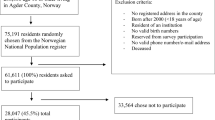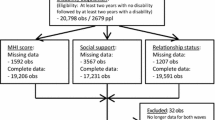Summary
The associations between social disablement and socio-demographic factors have been examined in a random sample of 310 adults drawn from the general population of Camberwell, South London. Neither paternal social class nor the subject's own social class are associated with social disablement in either men or women, except that men (but not women) of very low social class show significantly poorer social performance. Age and sex are not associated with social disablement, despite the fact that women in the general population have consistently been found to have higher rates of psychiatric disorder than men. For a given level of psychiatric disorder men show poorer social performance than women. Men who do not have children at home, or who live entirely alone have significantly poorer social performance, as do men who are widowed, separated or divorced, but these factors are not associated with poor social performance in women. By contrast, an unsatisfactory marital relationship is significantly associated with disablement in women, but not in men. The demographic factors associated with poor social performance are all indices of social disadvantage or social isolation.
Similar content being viewed by others
References
Bebbington P, Hurry J, Tennant C, Sturt E, Wing J (1981) Epidemiology of mental disorders in Camberwell. Psychol Med 11: 561–579
Brown GB, Harris TO (1978) Social origins of depression: a study of psychiatric disorder in women. Tavistock, London
Cohen J (1960) A coefficient of agreement for nominal scales. Educ Psychol Meas 20: 37–46
Dohrenwend BP, Dohrenwend BS (1974) Social and cultural influences on psychopathology. Ann Rev Psychol 25: 417–452
Falloon IRH, Lindley P, McDonald R, Marks I (1977) Social skills training of out-patient groups. Br J Psychiatry 131: 599–609
Goldthorpe J, Hope K (1974) The social gradings of occupations. A new approach and scale. Oxford University Press, London
Hirsch SR, Platt SD, Knights AK, Weyman A (1979) Shortening hospital stay for psychiatric care: effect on patients and their families. Br Med J 1: 442–446
Hurry J, Tennant C, Bebbington P (1980) The selective factors leading to psychiatric referral. Acta Psychiatr Scand [Suppl] 285: 315–323
Hurry J, Sturt E (1981) Social performance in a population sample: relation to psychiatric symptoms. In: Wing JK, Bebbington P, Robins LN (eds) What is a case? Grant McIntyre, London
Hurry J, Bebbington PE, Tennant C (1983) Psychiatric symptoms and social disablement as determinants of illness behaviour (in prep)
Justice B, McBee GW (1978) Sex differences in psychological distress and social functioning. Psychol Rep 43: 659–662
Leff J, Vaughn C (1983) Expressed emotion in families: its significance for MI (in press)
Office of Population Censuses and Surveys (OPCS) (1970) Classification of occupation, 1970. HMSO, London
Paykel ES, Weissman M (1973) Social adjustment and depression: a longitudinal study. Arch Gen Psychiatry 28: 659–663
Paykel ES, Weissman M, Prusoff BS (1978) Social maladjustment and severity of depression. Compr Psychiatry 19: 121–128
Phillips L (1968) Human adaptation and its failure. Academic Press, New York
Sturt E, Bebbington P, Hurry J, Tennant C (1981) The present state examination used by interviewers from a survey agency. Report from the MRC Camberwell Community Survey. Psychol Med 11: 561–579
Weissman M (1975) The assessment of social adjustment. Arch Gen Psychiatry 32: 357–365
Weissman M, Prussoff B, Thompson W, Harding P, Myers J (1978) Social adjustment by self report in a community sample and in psychiatric out-patients. J Nerv Ment Dis 166: 317–326
Wing JK, Nixon JM, Mann SA, Leff JP (1977) Reliability of the PSE, 9th ed used in a population survey. Psychol Med 7: 505–516
Wing JK, Sturt E (1978) The PSE-ID-CATEGO System: a supplementary manual. Institute of Psychiatry, London
Author information
Authors and Affiliations
Rights and permissions
About this article
Cite this article
Hurry, J., Sturt, E., Bebbington, P. et al. Socio-demographic associations with social disablement in a community sample. Soc Psychiatry 18, 113–121 (1983). https://doi.org/10.1007/BF00583561
Accepted:
Issue Date:
DOI: https://doi.org/10.1007/BF00583561




